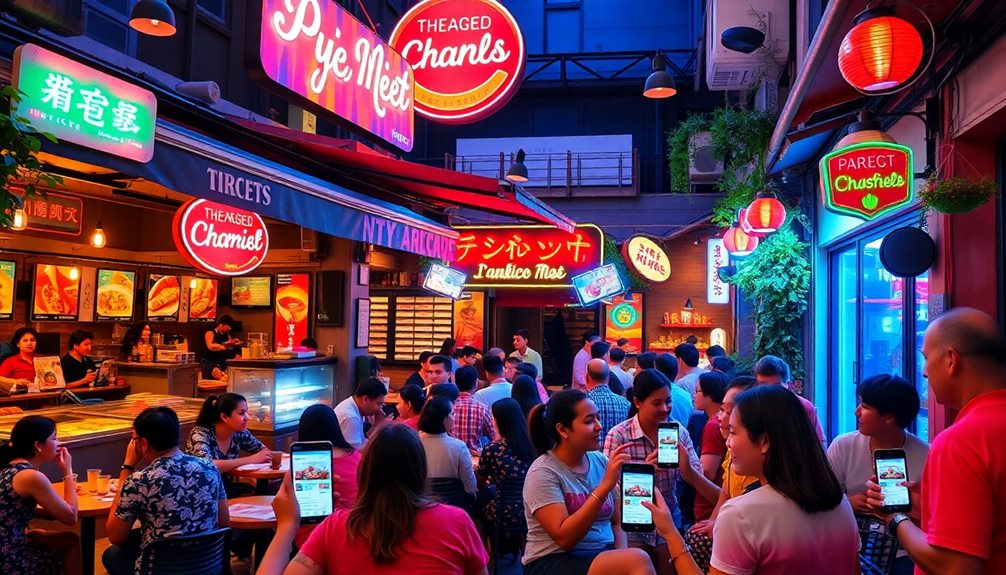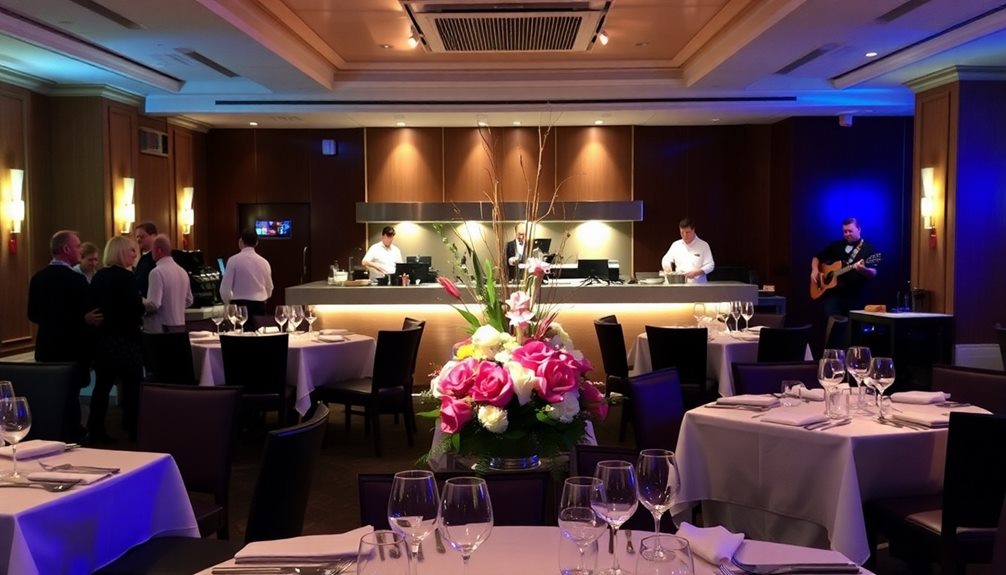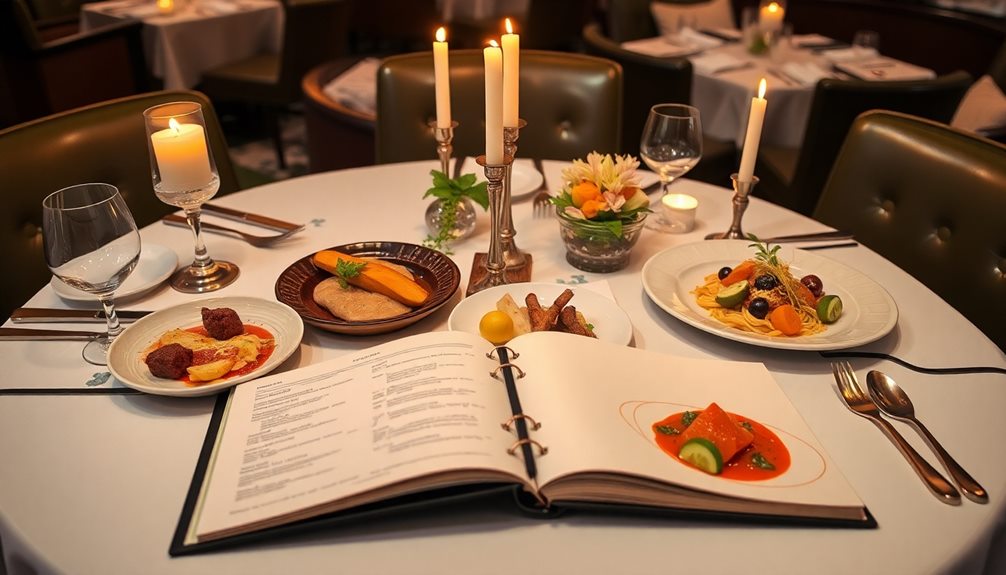To create a restaurant content calendar, start by identifying your target audience and understanding their preferences. Choose key social media platforms like Instagram and Facebook to reach them effectively. Plan themed content, such as "Meatless Mondays" or seasonal promotions, to maintain engagement. Schedule posts regularly, using a mix of high-quality food photos, behind-the-scenes content, and user-generated material. Don't forget to utilize hashtags to widen your reach. Finally, regularly analyze your performance metrics to refine your strategy. There's a lot more to explore about building a successful content calendar that resonates with your audience.
Key Takeaways
- Identify your target audience through demographic analysis and local dining trends to tailor content effectively.
- Plan a consistent posting schedule using a content calendar, incorporating seasonal themes and promotional campaigns.
- Utilize various social media platforms, focusing on visual content for Instagram and engaging videos for TikTok.
- Engage your audience with user-generated content, polls, and behind-the-scenes posts to build community.
- Monitor performance metrics regularly to refine strategies and ensure content remains relevant and engaging.
Importance of a Content Calendar
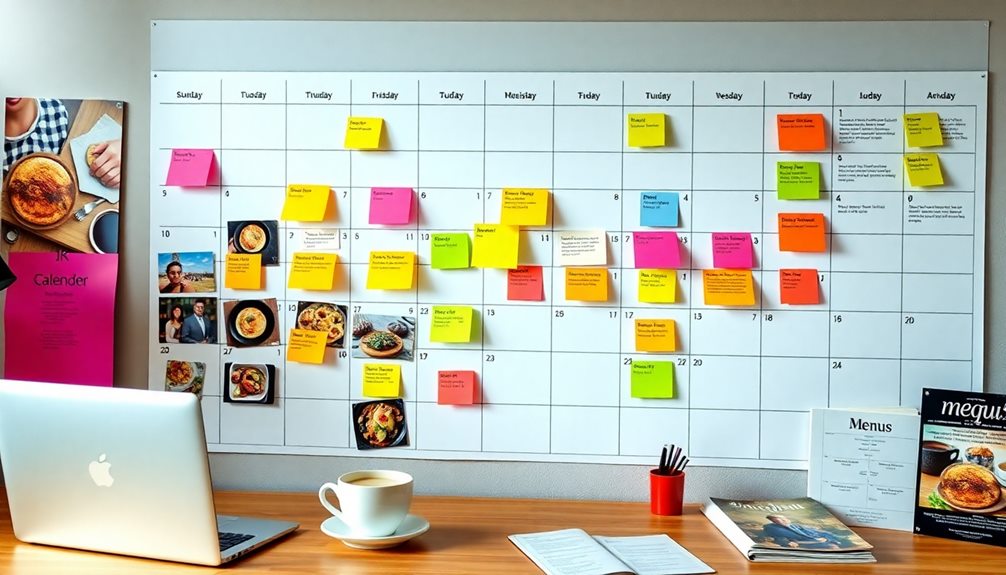
A content calendar is vital for any restaurant looking to boost its social media presence. By streamlining your social media strategy, it allows you to plan and schedule posts in advance, ensuring consistent engagement with your audience.
When you align your content with important events and seasonal trends, you not only enhance relevance but also improve your marketing effectiveness.
With a well-structured content calendar, you can markedly increase your brand visibility. Regular posting keeps your restaurant top-of-mind for customers, maintaining an active online presence that informs and captivates them.
Plus, this structured approach frees up valuable time for your team, letting them focus on other essential business areas while social media remains engaging.
Efficient tracking of your content's performance is another major benefit. By using a content calendar, you can analyze performance metrics easily, helping you identify what types of content resonate best with your audience.
This insight enables you to fine-tune your strategy, ensuring that your social media efforts aren't only consistent but also effective in driving engagement and attracting new customers.
Identifying Your Target Audience
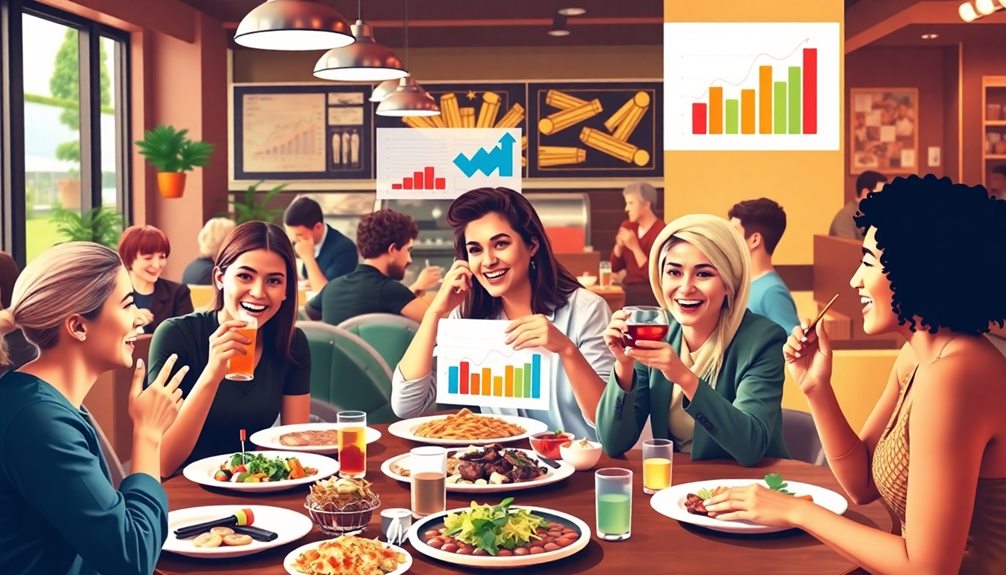
Identifying your target audience is vital for crafting a successful restaurant marketing strategy. Start by conducting a demographic analysis, examining factors like age, gender, income level, and education. This information helps you tailor your outreach efforts effectively.
Additionally, consider implementing strategies from creating a retirement savings plan to establish stability in your finances while you grow your business. Next, assess local preferences and dining trends to align your marketing strategies with the interests of the community you serve.
Understanding what cuisine types and price ranges appeal to your target audience guarantees that your menu and promotions resonate. If your establishment has a specific concept and ambiance, reflect that in your marketing efforts to attract the right demographics.
Don't forget to regularly reassess audience characteristics and preferences. The restaurant landscape is always evolving, so staying updated is essential for maintaining relevance.
Use insights from your assessments to adapt your content strategy and guarantee it continually engages your audience.
Key Social Media Platforms
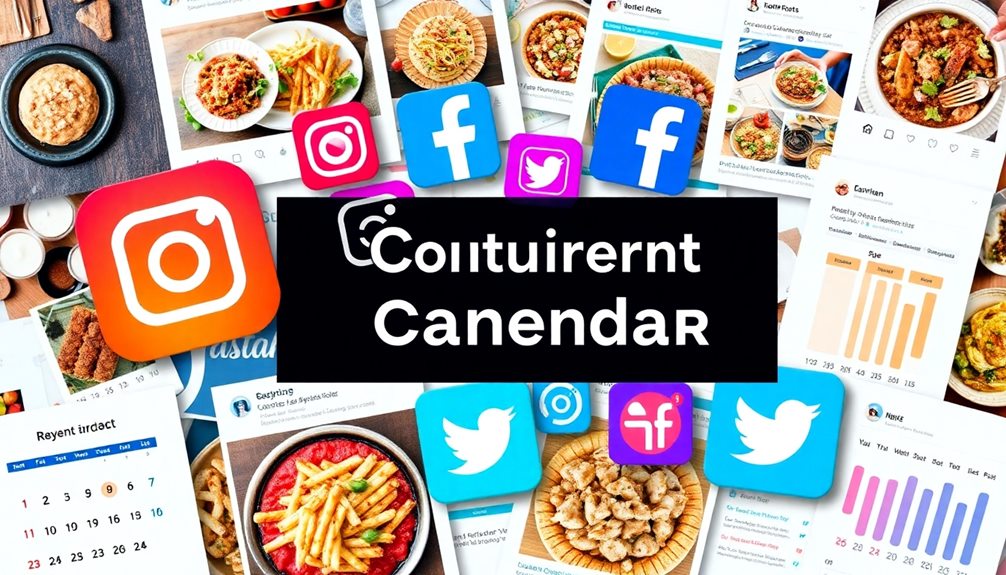
Once you've pinpointed your target audience, it's time to leverage social media platforms that can amplify your restaurant's reach. Each platform offers unique features that cater to different demographics and engagement styles, making them essential to your restaurant social media strategy.
- Facebook: With over 2.9 billion monthly active users, it's perfect for building community and sharing updates. Use it to engage with customers and create a loyal following.
- Instagram: Known for its visual appeal, Instagram boasts over 1 billion users. Showcase mouth-watering food photos and highlight your restaurant's ambiance to draw in food lovers.
- TikTok: Gaining traction with a younger audience, TikTok allows you to create engaging short-form videos that can go viral, markedly boosting your restaurant's visibility.
Don't forget about Pinterest, which is great for sharing recipes and menu ideas.
To maximize your impact, maintain a consistent posting frequency across platforms to keep your audience engaged. By selecting the right social media platforms and focusing on creating engaging content, you can effectively showcase your restaurant and attract new customers.
Types of Content to Include
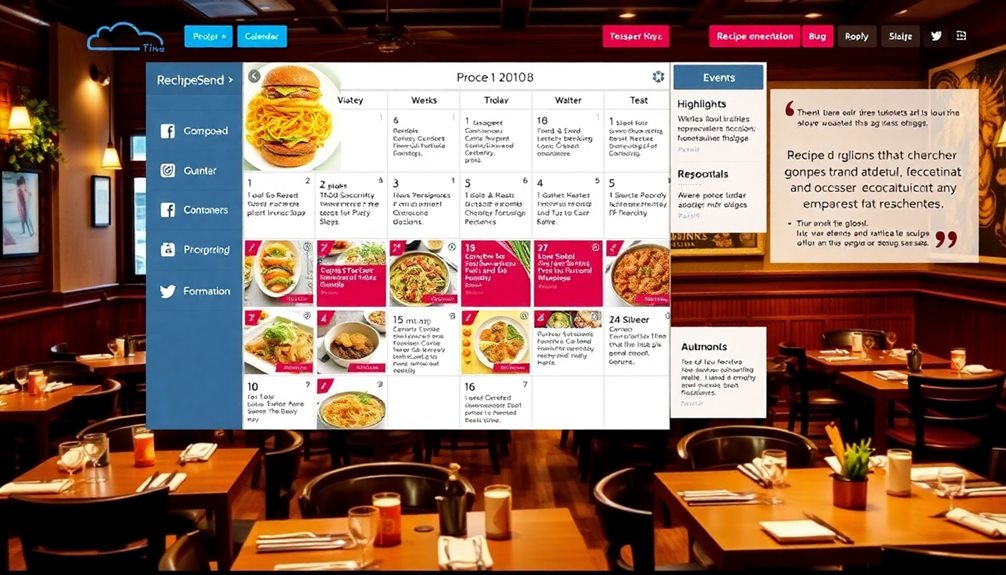
Engagement is key when creating a restaurant content calendar, and incorporating diverse types of content can greatly enhance your online presence. Here are some effective types of content to include:
| Type of Content | Description | Purpose |
|---|---|---|
| High-Quality Food Photos | Showcase menu items with appealing visuals and captions that highlight unique ingredients or family recipes. | Attract engagement and interest. |
| Behind-the-Scenes Content | Share videos of food preparation or staff introductions to humanize your brand. | Create a personal connection. |
| User-Generated Content | Feature posts from customers enjoying meals at your restaurant. | Enhance community engagement. |
| Seasonal or Holiday-Themed | Plan content around relevant holidays or events to resonate with audience interests. | Guarantee timely, appealing posts. |
Planning Your Posting Schedule

To effectively plan your posting schedule, you need to determine how often you'll share content and assign specific themes to each post.
Consider aiming for daily posts to keep your audience engaged while mixing in a variety of content types.
This approach not only maintains interest but also helps you connect with your followers on a deeper level.
Determine Posting Frequency
Finding the right posting frequency is essential for maximizing your restaurant's social media impact. You should aim for a frequency that aligns with your restaurant's capacity and audience engagement goals. Typically, posting once a day to three times per week will yield ideal reach.
To determine the best times to post, analyze peak engagement times on your preferred social media platforms using insights and analytics. Schedule your content during these active windows to enhance visibility.
Consider utilizing a social media content calendar to plan your posts ahead of time, allowing for flexibility based on trends or events. Incorporating themed days or weekly specials can also create consistency, building anticipation among your followers.
Here are a few tips to refine your posting frequency:
- Regularly review engagement metrics to understand what works.
- Adjust your strategy based on audience preferences and behaviors.
- Be open to changing your posting schedule if engagement dips.
Assign Content Themes
Creating a content calendar with assigned themes can streamline your restaurant's social media strategy and engage various audience segments throughout the month. By assigning content themes, you establish a structured posting schedule that guarantees a diverse range of topics. This approach makes it easy to brainstorm content ideas, like "Meatless Mondays" or "Throwback Thursdays," which can capitalize on trending interests and resonate with your audience.
Planning these content themes in advance saves you time during busy periods, allowing your team to concentrate on food preparation and customer service instead of scrambling for last-minute content. Aligning your themes with seasonal promotions or local events increases relevance and drives engagement.
Additionally, incorporating customer feedback into your theme planning can greatly boost audience interaction. Understanding what your customers enjoy helps tailor your content to their preferences, making your marketing ideas more effective.
Seasonal and Trending Topics
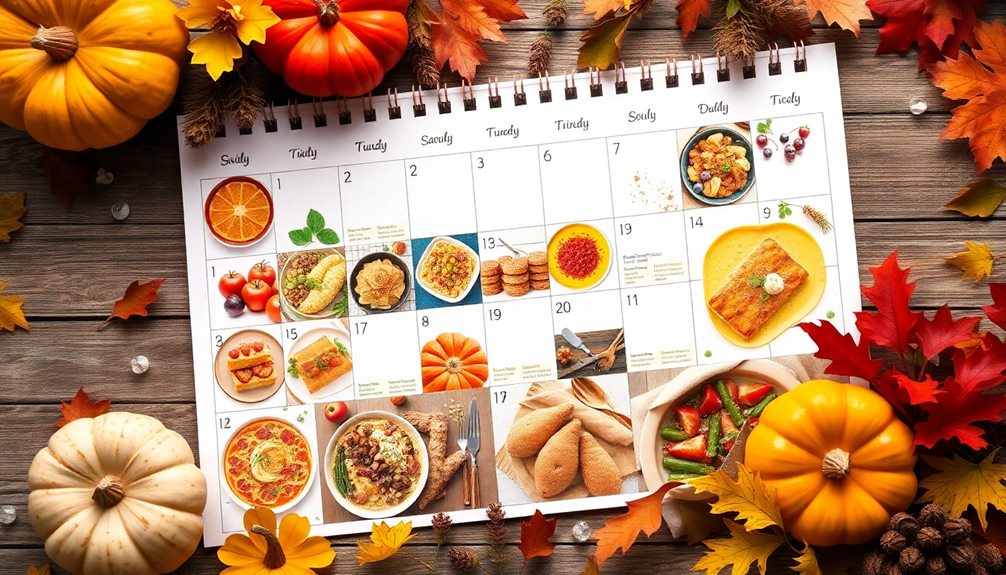
Incorporating seasonal and trending topics into your restaurant's content calendar not only keeps your posts relevant but also captivates your audience's interest. By aligning your content with seasonal themes and popular culinary trends, such as traditional Tuscan dishes, you can greatly boost engagement and drive sales.
Consider these strategies to enhance your content calendar:
- Research trending food items, like plant-based dishes or ethnic cuisines, to keep your menu and social media appealing.
- Plan promotional campaigns around seasonal ingredients or events, such as summer barbecues or winter comfort foods, to attract more customers.
- Utilize social media insights to identify popular hashtags and topics in your community, guaranteeing you connect with current conversations.
Regularly reviewing and updating your content calendar allows you to reflect emerging trends and seasonal opportunities. This proactive approach guarantees your posts remain fresh and engaging throughout the year.
Engaging Content Ideas
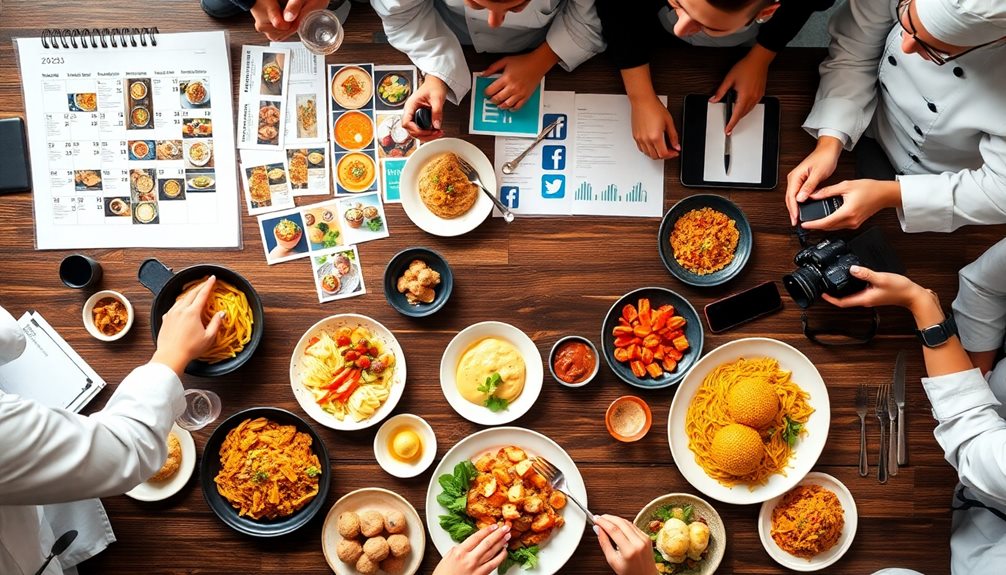
Engaging your audience with intriguing content ideas can elevate your restaurant's online presence and foster community connection.
Start by showcasing behind-the-scenes preparation. Share videos or photos of your chefs in action, giving followers an insider look at the culinary process. This not only highlights your team but also builds anticipation for your dishes.
Additionally, consider utilizing advertisement cookies to customize ads that resonate with your audience, potentially drawing in more engagement.
Highlight your daily or weekly signature dishes with high-quality images and engaging captions that emphasize unique ingredients or family recipes. This approach enhances your social media content creation and captivates your audience.
Encourage customer interaction by posting polls about their favorite menu items or asking for suggestions on new dishes to try. This involvement fosters a sense of community and strengthens your restaurant social media strategy.
Don't forget to share user-generated content by reposting photos from customers enjoying their meals. This enhances brand visibility and establishes a personal connection with your audience.
Utilizing Hashtags Effectively
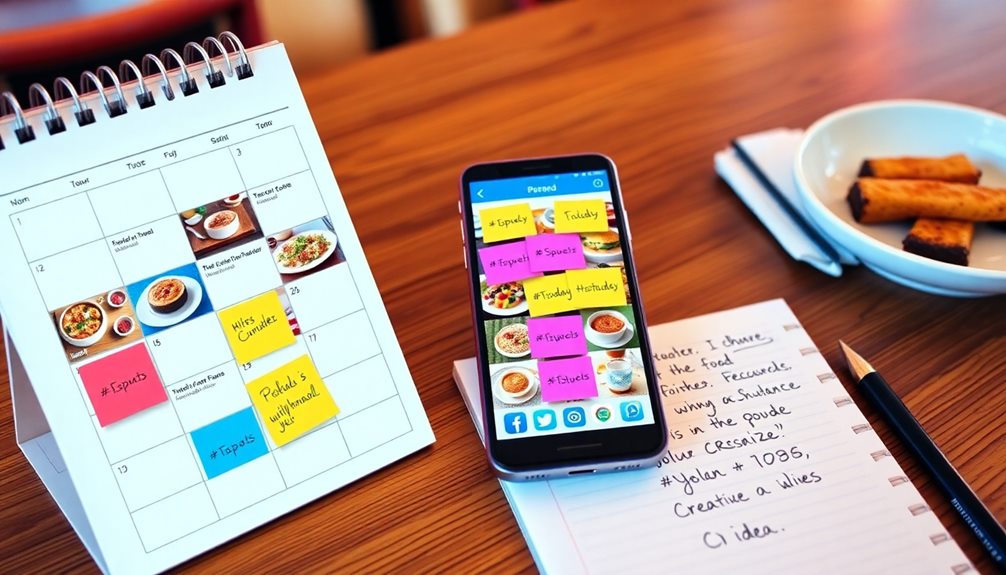
Hashtags play a pivotal role in amplifying your restaurant's online visibility and connecting with your audience. By using relevant hashtags in your social media posts, you can increase post visibility by up to 12.6%, attracting a targeted audience.
To maximize the impact of your restaurant social media strategy, consider these tips:
- Mix popular and niche hashtags: Popular hashtags increase reach, while niche tags foster higher engagement with less competition.
- Stay updated and experiment: Regularly refresh your hashtag combinations to keep your content relevant and discoverable.
- Engage with community-specific hashtags: This not only categorizes your posts but also builds a sense of belonging among local food enthusiasts.
Analyzing competitors and influencers can provide valuable insights into successful hashtags. By adapting their strategies, you can improve your content distribution and reach.
Keep in mind that trends change quickly, so being flexible in your approach will help maintain engagement with your audience. Start incorporating these strategies into your hashtag use to effectively engage with your community and enhance your restaurant's online presence.
Monitoring and Analyzing Performance
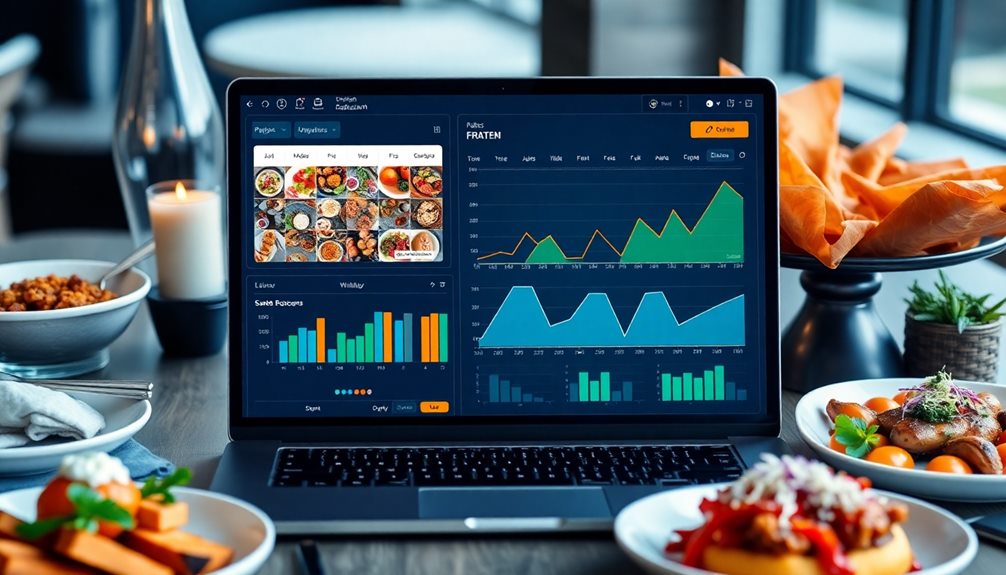
Tracking your restaurant's social media performance is crucial for understanding what resonates with your audience. Start by monitoring key performance metrics like engagement rates, reach, and click-through rates. These metrics help you evaluate the effectiveness of your content calendar and overall social media strategy.
Utilize the analytics tools provided by social media platforms to gain insights into your audience's demographics and behaviors. This information allows you to create more tailored content that appeals directly to your followers.
Don't forget to conduct A/B testing on various posts; experiment with visuals, captions, and hashtags to see what yields the highest engagement. Pay attention to feedback and comments from your followers, as they can offer valuable insights into their preferences and interests.
Schedule monthly reviews of your social media performance to identify trends, successes, and areas needing improvement. This practice enables you to continuously optimize your content calendar and adjust your social media strategy accordingly.
Tips for Continuous Improvement
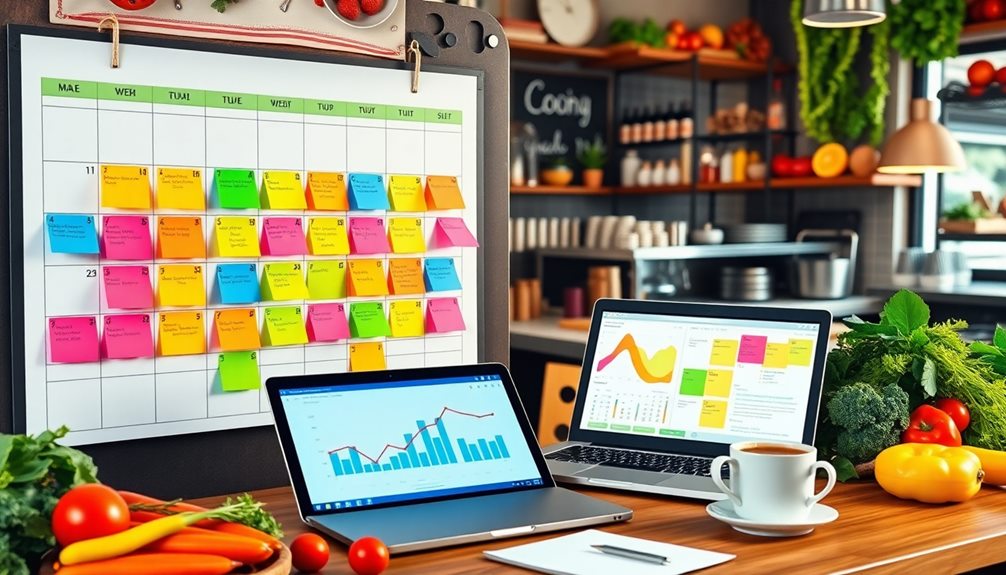
To keep your restaurant's content fresh and engaging, regularly analyze your performance metrics and adapt to emerging trends.
Encourage team collaboration to brainstorm new ideas and share insights that can enhance your strategy.
Regular Performance Analysis
Regular performance analysis is essential for refining your restaurant's content strategy and ensuring it resonates with your audience. By tracking key metrics, you can gauge the effectiveness of your social media presence and make necessary adjustments.
Utilize analytics tools provided by social media platforms to identify which types of posts engage your audience the most.
To enhance your approach, consider these strategies:
- Implement A/B testing: Experiment with different post formats, captions, and posting times to find what works best for your target demographic.
- Set clear Key Performance Indicators (KPIs): Focus on metrics like increased bookings or website traffic to measure the success of your efforts.
- Collect audience feedback: Regularly analyze comments and direct messages to gain insights into customer preferences and improve content relevance.
Adapt to Trends
Adapting to trends is essential for keeping your restaurant's content relevant and engaging. To achieve this, you need to stay informed about industry trends, seasonal events, and emerging social media features. This way, you can create timely content that resonates with your potential customers and enhances engagement.
Regularly analyze social media performance metrics to identify which types of posts generate the most audience engagement. Use this data to adjust your content strategy and optimize your reach.
It's also vital to utilize customer feedback and user-generated content, as these insights help you refine your approach to meet evolving customer preferences.
Experiment with different content formats and posting schedules based on ongoing performance analysis. This trial-and-error method will help you discover what truly works best for your audience.
Additionally, consider collaborating with influencers and local food bloggers. Their insights into current food trends can provide valuable ideas to integrate into your content strategy, allowing you to ride the wave of popular topics.
Encourage Team Collaboration
Creating a successful restaurant content calendar relies heavily on team collaboration. By fostering a collaborative environment, you can harness the creativity and expertise of your team members.
Utilize shared digital tools like Google Sheets or project management software to allow everyone to contribute content ideas and updates in real time.
To enhance the variety and relevance of your content, schedule regular brainstorming sessions. Here are some key practices to implement:
- Assign specific roles: Designate responsibilities for content creation, scheduling, and monitoring to guarantee accountability.
- Implement feedback loops: Encourage team members to review and provide input on past content performance for data-driven improvements.
- Celebrate contributions: Publicly acknowledge team efforts and successes to motivate continuous improvement in content quality.
Frequently Asked Questions
How Do I Create a Simple Content Calendar?
To create a simple content calendar, define your posting frequency and key themes. Use a digital tool to organize posts, schedule diverse content types, and update regularly based on performance and audience feedback for ideal engagement.
How to Create a Schedule for a Restaurant?
Creating a restaurant schedule might feel overwhelming, but it's manageable! Start by outlining shift needs, considering peak times, and involving your team. Regularly adjust to fit both employee preferences and customer demand for maximum efficiency.
How Much Does It Cost to Create a Content Calendar?
Creating a content calendar can cost anywhere from free tools to $150 per hour for expert help. It's crucial to choose options that fit your budget while maximizing engagement and organization for your goals.
How Do I Create a Digital Marketing Calendar?
To create a digital marketing calendar, start by identifying key dates and themes. Use tools like Google Calendar to organize activities, and regularly review your progress to adjust strategies based on performance and audience feedback.
Conclusion
Creating a restaurant content calendar is like planting seeds in a garden. With each post, you nourish your brand, cultivate connections, and watch your community bloom. As you embrace your audience's tastes and preferences, you'll harvest not just likes and shares, but loyal patrons who cherish your story. So, keep tending to your calendar, adapt to the changing seasons, and let your restaurant's unique flavor shine through. After all, every great meal starts with a thoughtful recipe.

